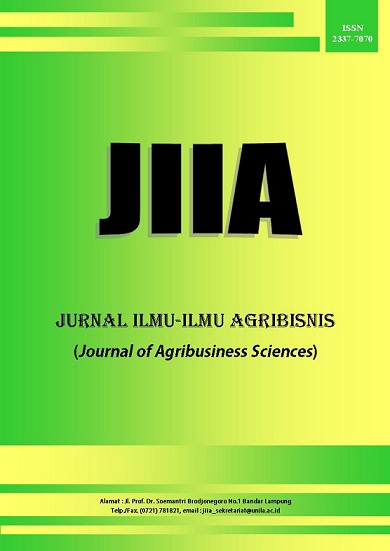PENDAPATAN DAN KESEJAHTERAAN RUMAH TANGGA PETANI UBI KAYU DI KECAMATAN SUKADANA KABUPATEN LAMPUNG TIMUR
DOI:
https://doi.org/10.23960/jiia.v2i3.807 Abstract View: 2677
Abstract View: 2677
Abstract
The purpose of this study was to analyze the cassava farm income, determine the amount of household income of cassava farmers, determine the level of welfare of households by household expenditure cassava farmers. The study was conducted using a survey method in District Sukadana, East Lampung regency. The location was conducted in Sukadana District, and it was selected purposively. Respondents were 48 cassava farmers drawn using simple random sampling method. Data were analyzed qualitatively and quantitatively. The results showed that average income of cassava farmers based on cash costs and total cost of Rp 21,931,956.9/year and USD 20,795,322,09/th per hectare. This Farming was beneficial because it gained acceptance ratio and the ratio obtained over and above the total cash cost (R/C ratio) of 4.71 and 3.95. Average household income of cassava farmers was Rp27,126,481.25 / years. Sajogyo criteria, there were 38 farm household were classified as peasants and 18 of them were classified as simple household.
Keywords: Cassava, expenditures, household welfare income
Downloads
Downloads
Published
How to Cite
Issue
Section
License
Authors who publish with this journal agree to the following terms:
Authors retain copyright and grant the journal right of first publication with the work simultaneously licensed under a Creative Commons Attribution License that allows others to share the work with an acknowledgement of the work's authorship and initial publication in this journal.
Authors are able to enter into separate, additional contractual arrangements for the non-exclusive distribution of the journal's published version of the work (e.g., post it to an institutional repository or publish it in a book), with an acknowledgement of its initial publication in this journal.
Authors are permitted and encouraged to post their work online (e.g., in institutional repositories or on their website) prior to and during the submission process, as it can lead to productive exchanges, as well as earlier and greater citation of published work (See The Effect of Open Access).














